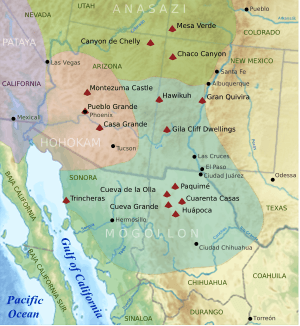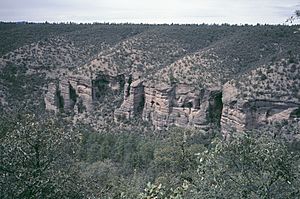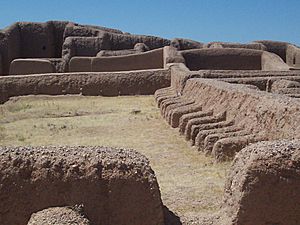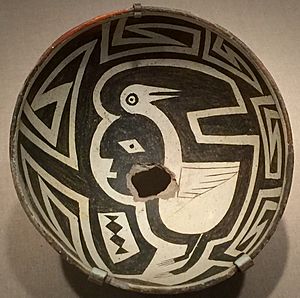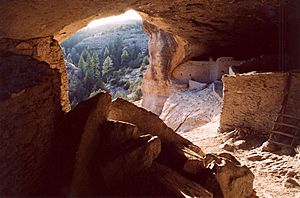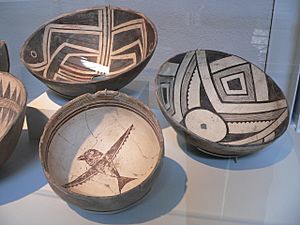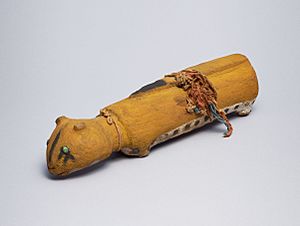Mogollon culture facts for kids
The Mogollon culture (pronounced moh-goh-YOHN) was a group of Native American people who lived in parts of what is now Southern New Mexico and Arizona, Northern Sonora and Chihuahua in Mexico, and Western Texas. This culture existed in a region called Oasisamerica in the north and Aridoamerica in the south.
The Mogollon culture is one of the main ancient groups from the Southwestern United States and Northern Mexico. This culture thrived from about 200 CE until around 1450 or 1540 CE, which is when Spanish explorers arrived.
Contents
What Does "Mogollon" Mean?
The name Mogollon comes from the Mogollon Mountains. These mountains were named after Don Juan Ignacio Flores Mogollón. He was the Spanish Governor of New Spain (which included New Mexico) from 1712 to 1715. An archaeologist named Emil W. Haury chose this name in 1936.
What Made the Mogollon Culture Special?
Archaeologist Emil Haury found unique things about the Mogollon culture. He studied sites in New Mexico in the 1930s. He noticed differences from other nearby cultures like the Hohokam and Ancestral Pueblo.
Key differences included their pottery, which was brown and made using a coil-and-scrape method. They also built deep, semi-underground houses called pit-houses. Their special ceremonial buildings were also different. Today, experts still agree that Mogollon pottery, building styles, tools, and burial customs were very distinct.
The first Mogollon pithouses were deep and shaped like circles or ovals. Later, they built rectangular houses with rounded corners that were not as deep. Their villages also had kivas. These were round, semi-underground buildings used for ceremonies.
A Look at Mogollon History
No one is completely sure how the Mogollon culture began. One idea is that they came from an older group called the Desert Archaic people. These people lived in the area around 9000 BC. As more people arrived, they started forming villages.
Another idea is that the Mogollon people came from farming areas in central Mexico around 3500 BC. They might have replaced the Desert Archaic people. A third idea is that they came from the Cochise culture around 5000 BC. These people learned farming from Central Mexico.
At first, the Mogollon people mostly gathered food. They also did some farming. Over time, farming became more important to them. They even built systems to control water for their farms between the 10th and 12th centuries CE.
Mogollon villages changed over time. The earliest villages had several pithouses. These were houses dug into the ground with roofs made of sticks, thatch, and earth. By the 11th century, they started building surface pueblos. These were ground-level houses with walls of rock and earth. In the 13th and 14th centuries, cliff-dwellings became common.
Researchers have found different regional groups within the Mogollon culture. The most famous is the Mimbres culture. Other groups include the Jornada, Forestdale, and San Simon. The Mimbres culture is well-known, but the entire Mogollon culture lasted much longer and covered a much larger area.
How Mogollon Culture Developed
Historians often divide Mogollon history into periods based on how their housing changed:
- Early Pithouse Period (200–550 CE): People lived in deep pit-houses.
- Late Pithouse Period (550–1000 CE): Pit-houses became less deep.
- Mogollon Pueblo Period (1000–1450 CE): People started living in pueblos and cliff dwellings.
Important Mogollon Sites
Archaeological sites linked to the Mogollon culture are found in many places. These include the Gila Wilderness, the Mimbres River Valley, and along the Upper Gila river. Other sites are Paquime and Hueco Tanks.
The Gila Cliff Dwellings National Monument in New Mexico is a famous site. It was made a national monument in 1907. It has several sites from the Mimbres branch of the Mogollon culture. The Hueco Tanks State Historic Site is about 32 miles northeast of El Paso, Texas.
Mimbres Culture: A Special Group
The "Mimbres" refers to a special group within the Mogollon culture. It can also mean a specific time period called the "Classic Mimbres phase" (1000–1130 CE).
The Mimbres group lived mainly in the Mimbres Valley. Their unique style is clearest during the Three Circle (825–1000 CE) and Classic Mimbres (1000–1150) phases. During these times, their buildings and black and white pottery looked very distinct. Classic Mimbres pottery is especially famous. Its designs were even copied on dinnerware for the Santa Fe Railroad from 1936 to 1970.
Three Circle phase villages had pit-houses that were often square-shaped. They had plastered floors and walls. Their pottery included early forms of Mimbres black and white designs. They also had large ceremonial buildings dug deep into the ground.
Classic Mimbres phase (1000–1130 CE) pueblos could be very large. Some had up to 150 rooms grouped around an open plaza. Their ceremonial buildings were different from earlier times. They often had special rooms inside the main buildings. The largest Mimbres sites were near wide, well-watered areas good for growing corn.
Mimbres Pottery: Art and History
Mimbres pottery, especially bowls, is very unique. It has geometric patterns and pictures of animals, people, and cultural symbols. These designs are painted in black on a white background. Some pictures suggest they knew about cultures in northern and central Mexico. The detailed art shows that the Mimbres Mogollons had a rich ceremonial life.

Early Mimbres pottery had bold geometric designs. Later, both geometric and animal/human designs became more detailed. Classic Mimbres pottery (Style III) shows very fine lines and detailed artwork. Bird figures are common, like turkeys eating insects. Fish figures are also seen, including some from the Gulf of California.
Mimbres bowls are often found with burials. They usually have a hole punched in the center, called a kill hole. Bowls with kill holes were often placed over the face of the buried person. However, most pottery was not buried. Marks on the inside of bowls show they were used daily.
Because of its unique style, Mimbres pottery became very popular. This led to people illegally digging up graves to find pots, starting in the 1960s.
For a long time, people thought the Mimbres people "disappeared" when they stopped making this pottery around 1130 to 1150 CE. But newer research shows that some people stayed in the Mimbres Valley. Others moved to different areas and changed their pottery styles to be more like their neighbors.
Who Are Their Descendants Today?
The area where the Mogollon culture lived was later settled by the Apache people, who came from the north. However, many modern Pueblo people in the southwest believe they are related to the Mogollon and other similar ancient cultures.
Archaeologists think that the Western Pueblo villages of the Hopi and Zuni people might be connected to the Mogollon. Pottery styles and oral history link the Acoma, Hopi, and Zuni people to the Mogollon.
See also
 In Spanish: Cultura Mogollón para niños
In Spanish: Cultura Mogollón para niños


